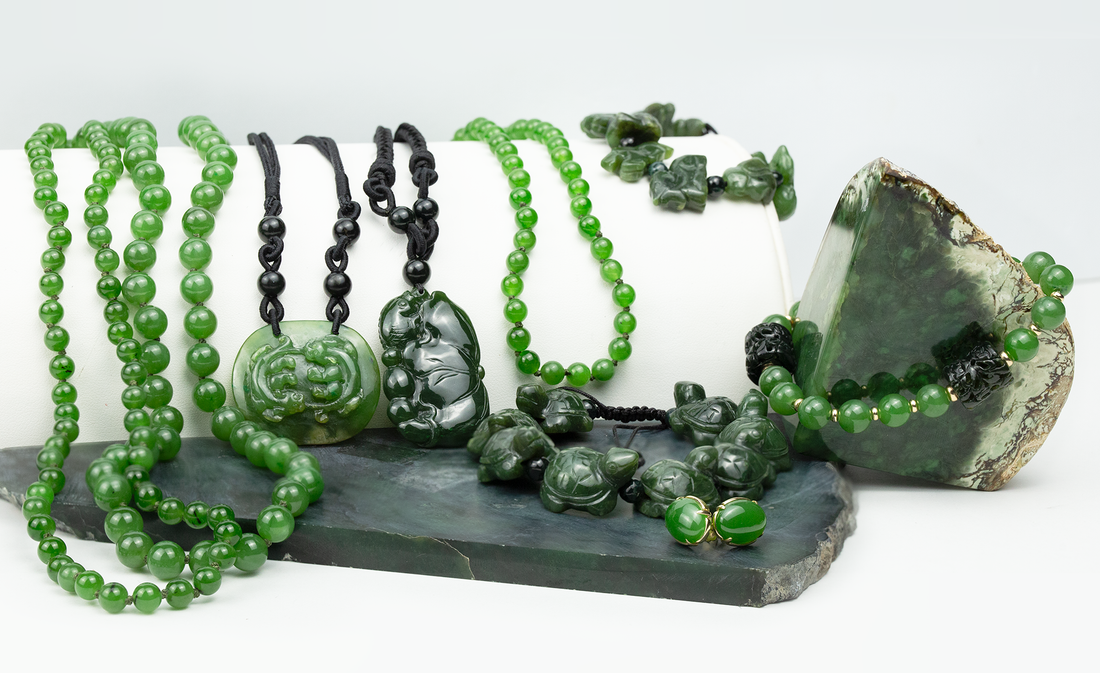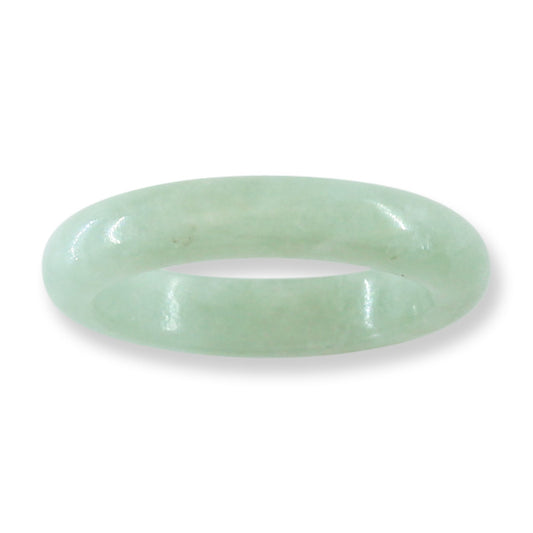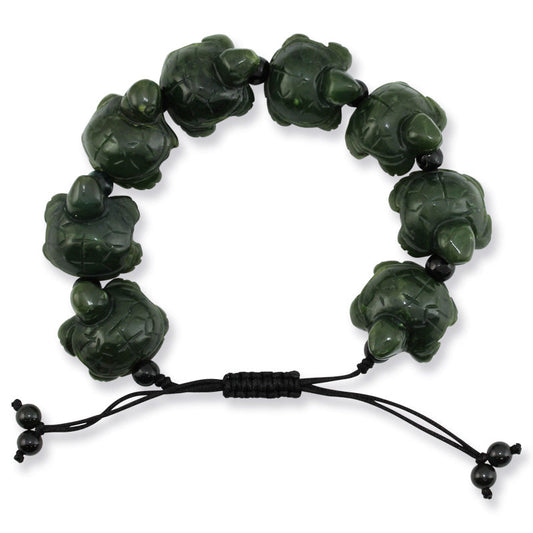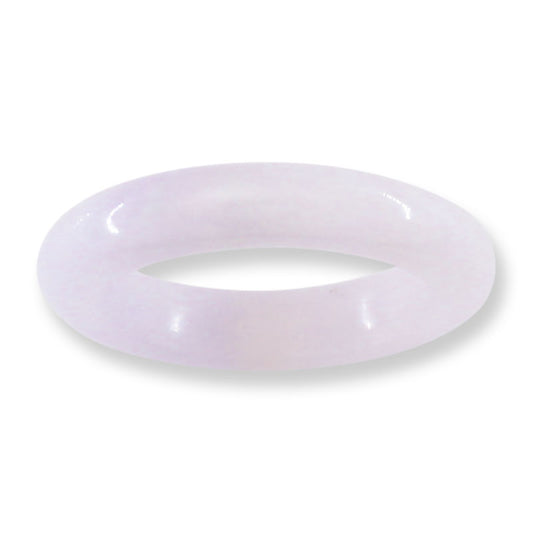When most people hear the word jade, they think of a green gemstone. But in gemology, jade actually refers to two entirely different minerals: nephrite jade and jadeite jade (also called fei cui). Both have been treasured across continents and cultures for thousands of years—but they are chemically and visually distinct. Understanding their differences can help you appreciate their unique qualities and make smarter choices when shopping for jade.

Natural green jadeite jade beads from Mason-Kay Jade
Jade in China
Nephrite jade is the original jade of ancient China. For millennia, it was revered for its incredible toughness, soothing luster, and a texture so homogenous that it can only be compared to “mutton fat”—so refined and flawless it was seen as a symbol of purity. As Kirk Makepeace, founder of Jade West, put it at the 2025 International Jade Summit when describing jade’s appeal: “It’s not a bling thing.”
Jadeite jade, on the other hand, didn’t arrive in China until the 1700s, when the Qing Dynasty opened trade with what is now Myanmar. Emperor Qianlong, an obsessive jade collector, was mesmerized by its vibrant green hue and apparent inner glow, describing it as “poetry without words.”
Today, jade is believed to be a $30 billion industry in China. Under Mao Zedong, China remained isolated from the world, but jade re-emerged as a vital cultural and economic symbol during Deng Xiaoping’s leadership. Jade helped fuel China’s economic resurgence, and remains a central expression of Chinese identity and artistry.

Photo taken at Jade Maya's Hacienda Santiago in Zapata, Guatemala. Learn more about Guatemala's modern-day jade culture in this video Inside a Guatemalan Jade Mine from Jewels of the Trade.
Jade in Mesoamerica
Unlike China, Mesoamerican cultures worked exclusively with jadeite jade—not nephrite. From around 1500 BC to the 1500s AD, jadeite was carved into tools, jewelry, masks, and ceremonial objects by civilizations like the Olmec, Maya, and Aztec. After the Spanish Conquest, jade carving in Central America disappeared—its source forgotten for centuries.
It wasn’t until the 1970s that Jay Ridinger and Mary Lou Johnson (now Ridinger) rediscovered Guatemala’s jadeite deposits, reviving an ancient art form that had been lost for 500 years.

The Nephrite Jade Collection, a limited-time only collection from Mason-Kay Jade
Why Are There Two Jades?
The word jade is an English trade term—not a scientific one—which has led to confusion and misuse. Some sellers even apply it to stones that aren’t jade at all. But gemologists define minerals by their chemical composition and crystal structure, metrics by which nephrite jade and jadeite jade are strictly defined. Gemologically, in the USA, only nephrite jade and jadeite jade are considered “jade.” Beware of sellers overusing the word “jade” without clarifying the actual gemstone type. Always ask the seller “Which jade is this?” If they can’t answer you, that’s a serious red flag.
In the 1800s, French mineralogist Alexis Damour made the distinction between nephrite and jadeite – though he wasn’t as helpful as it sounds like he was. After seeing bright green jadeite jade artifacts looted from the Summer Palace outside of Beijing in 1860, he coined the term jadeite to differentiate this material from what he called “Oriental jade” (nephrite). At the time, he didn't realize that jadeite was a polycrystalline aggregate—what gemologists now refer to specifically as jadeite jade, and what geologists might call jadeitite.
Characteristics of Nephrite Jade
Nephrite jade is prized for:
-
Color: Especially white, but also found in green, black, yellow, brown, red, blue, and purple.
-
Texture: Opaque, dense, and often described as “greasy” in luster.
-
Durability: Nephrite is extremely tough—ideal for bangles and carvings.
-
Sonority: When struck, high-quality nephrite can produce a clear, ringing “ping.”
Today, most gem-grade nephrite comes from Russia, China, and Canada. Though geologically abundant, true gem-quality nephrite is rare.
Nephrite supports three main jade industries:
-
Antique nephrite from pre-Republic Chinese dynasties, often white.
-
Modern carvings, where jade is used as an artistic medium.
-
Gemstones for Jewelry, especially beads, bangles, and cabochons, which benefit from nephrite’s toughness.
Characteristics of Jadeite Jade
Jadeite jade is valued for:
-
Color: Green is the most sought-after—especially vivid, translucent “imperial jade.” But it also comes in lavender, blue, red, yellow, black, grey, white, and brown.
-
Translucency: One of the biggest value factors—more transparency often means higher value.
-
Hardness: Slightly harder than nephrite, which helps resist scratching.
-
Sonority: Like nephrite, it can produce a resonant tone when struck.
-
Rarity: Gem-quality jadeite is extremely rare, and the finest grades fetch the highest prices.

A Word on Treatment
Nephrite jade is rarely treated. But most jadeite jade on the market is treated—often chemically bleached, dyed, and impregnated with polymers to improve color and clarity. This weakens the stone and lowers its durability, even though it’s sometimes sold at deceptively high prices.
That’s why Mason-Kay only sells natural, untreated jadeite jade. When shopping for jade, always ask for a certificate of testing—and buy from a trusted source.
Frequently Asked Questions
Which jade is more valuable?
Both nephrite and jadeite jade can range from affordable to high-end. However, fine jadeite jade tends to command higher prices due to its rarity, especially when it meets the criteria for imperial jade.
Which jade is better for everyday wear?
Both are suitable for daily wear. Nephrite is tougher, meaning it's harder to break. Jadeite is harder, meaning it’s more resistant to scratching. Choose based on your lifestyle and the look you love.
At Mason-Kay, we believe in honoring the legacy and beauty of both jades. Whether you’re drawn to the creamy luster of nephrite or the luminous glow of fine jadeite jade, our commitment remains the same: only natural, untreated jade. Always.





